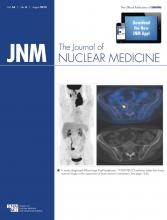C. Aktolun and S.J. Goldsmith, eds.
New York, NY: Springer-Verlag, 2012, 443 pages, $179
This book will be helpful to nuclear medicine physicians, residents, and research scientists who are eager to learn the state of the art concerning targeted radionuclide therapy, both in clinical practice and in recent clinical investigations and trials. This book is devoted entirely to nuclear medicine therapy, which includes topics ranging from clinical applications to basic knowledge on nuclear medicine technology and radiobiology related to therapy. The publication of this book reflects a rising interest in nuclear medicine therapy and mounting pressure to improve targeted therapy in clinical practice.
So as to comprehensively cover the topic, this book comprises 3 parts and 23 chapters, each collating a detailed historical review and cutting-edge research data. The first part, taking up the majority of the book (16 of 23 chapters), covers the use of radionuclide therapy in individual malignant diseases and the recent progress in treatment that has occurred, such as the use of radioimmunotherapy for lymphoma. The second part of the book, consisting of 2 chapters, covers the use of nuclear medicine therapy in benign diseases. This section represents the reality of clinical practice and the need for relentless efforts to expand the clinical applicability of nuclear medicine therapy to benign diseases as well. The third part, which can be considered a unique virtue of this book, deals with basic knowledge on radiobiology, radiation safety, and related issues. Among these issues, radiation safety is emphasized in parallel with the development of nuclear medicine therapy and, in the post–Fukushima accident era, the need to prepare ourselves to cope with public emergencies.
It is undeniable that 18F-FDG PET/CT has greatly developed and changed cancer imaging and management over the past 2 decades. Ironically, this splendid development and growing prosperity of nuclear medicine as an imaging specialty has obscured the traditional identity of nuclear medicine, just as had concerned the authors and thus brought about their encouraging, in the preface, the survival of “pure” nuclear medicine. We agree that strengthening nuclear medicine therapy will greatly help to solidify the clinical role of nuclear medicine and reinforce its academic identity. On the other hand, it is a bit worrisome that most nuclear medicine therapies and protocols introduced in this book are still evolving and yet to be established.
After reviewing the book in greater detail, we found that each chapter has unique characteristics representing the uniqueness of its authors and of the subdiscipline it covers. For example, the chapter on prostate cancer is succinct and a good model for the other chapters, although nuclear medicine therapy for prostate cancer is not yet prevalent. The chapter on radioiodine therapy for thyroid cancer is an eloquent summary of the cumulative wisdom on this topic acquired over the many years it has been in use by the medical community. However, several chapters describing radioactive antibody therapy against various cancers did not convey sufficient insight about our long struggle to integrate nuclear medicine therapy with established treatments such as chemotherapy and antibody/kinase inhibitors. In studying these chapters, readers will want to acquire vision on the reasons for our failure and might be disappointed by the complexity of a field full of discarded hopes and lacking prospects on how to amalgamate nuclear medicine therapy with existing and evolving cancer treatments. Outdated trials should have been so indicated and the causes of failure explained. The chapter on colorectal cancer needs to be edited further or abbreviated and the number of references reduced. From the brain tumor chapter, we could not easily grasp the uniqueness of brain tumor treatments and the proper positioning of nuclear medicine therapy to the period between surgery and radiotherapy.
After having read the book from cover to cover ourselves, in addition to reading it line by line with our nuclear medicine students, we were left with more questions than answers. How might cancer be treated by the cytostatic and cytocidal effects of nonspecific chemotherapy or by targeted therapy combined with nuclear medicine therapy? What will be the effect of dose and dose rate on the final outcome of existing combined radionuclide therapies and other combined chemoradiotherapies? What kind of molecular biologic knowledge (cell cycles, cell death, tumor heterogeneity, cancer stem cells, oncogene addiction, driver mutation, radioresistance de novo or developing) will help us construct beneficial combination chemo-radionuclide radiotherapies? Such issues came to be the focus of our attention. The third part of the book, on basic knowledge, was expected to provide insight on these puzzling problems but did not. A separate book may be needed for this purpose. Other causes for minor dissatisfaction with the book were the use of the same abbreviation, RAIT, for different terms in different chapters and differences in reference order between chapters.
Despite these critical comments and minor shortcomings in editing, the young nuclear physicians with whom we shared this book liked it, especially the individual chapters pertaining to their own interests. Thus, we extend credit to the authors of the individual chapters and recommend this worthwhile book to clinicians and nuclear medicine scientists. Reading this book will be a good starting point for learning the present status of nuclear medicine therapy.
Footnotes
Published online Jun. 7, 2013.
- © 2013 by the Society of Nuclear Medicine and Molecular Imaging, Inc.







